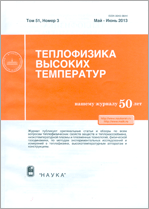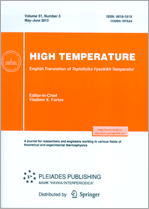|
This article is cited in 1 scientific paper (total in 1 paper)
Short Communications
AC electric discharge in a $1\%$ sodium chloride solution in distilled water at low pressures
A. A. Khafizova, R. I. Valieva, L. N. Bagautdinovab, Az. F. Gaisinc, Al. F. Gaisind, F. M. Gaisinb, E. E. Sond, I. T. Fakhrutdinovab
a Kazan (Volga Region) Federal University
b Kazan National Research Technical University named after A. N. Tupolev
c Kazan State Power Engineering University
d Joint Institute for High Temperatures, Russian Academy of Sciences, Moscow
Abstract:
The results of an experimental study of an alternating current discharge with a frequency of $50$ Hz in a gas-liquid medium of a $1\%$ of $\rm NaCl$ solution in distilled water with air bubbles and microdischarges inside a dielectric tube with a diameter of $10$ mm at reduced pressures for various interelectrode distances of copper electrodes—$50{,}~100$, and $150$ mm—are presented. A qualitative mechanism for the development of a breakdown and discharge at low pressures in a gas-liquid medium is established. It is found that with a decrease in pressure, a gas-liquid medium is formed, saturated with small air bubbles ranging in size from $1$ to $3$ mm as a result of boiling and electrolysis. This, in turn, leads to a breakdown and rapid discharge ignition in a porous medium near a solid electrode. The transition of an electric discharge with microdischarges to a volumetric discharge at low pressures is established. A fast Fourier transform was carried out, and the discharge voltage and current spectra were determined at reduced pressures.
Received: 24.01.2022
Revised: 21.02.2022
Accepted: 07.06.2022
Citation:
A. A. Khafizov, R. I. Valiev, L. N. Bagautdinova, Az. F. Gaisin, Al. F. Gaisin, F. M. Gaisin, E. E. Son, I. T. Fakhrutdinova, “AC electric discharge in a $1\%$ sodium chloride solution in distilled water at low pressures”, TVT, 60:4 (2022), 625–628; High Temperature, 60:4 (2022), 570–573
Linking options:
https://www.mathnet.ru/eng/tvt11709 https://www.mathnet.ru/eng/tvt/v60/i4/p625
|


| Statistics & downloads: |
| Abstract page: | 154 | | Full-text PDF : | 76 | | References: | 26 |
|





 Contact us:
Contact us: Terms of Use
Terms of Use
 Registration to the website
Registration to the website Logotypes
Logotypes








 Citation in format
Citation in format 
